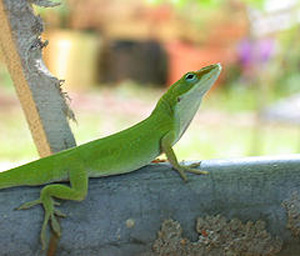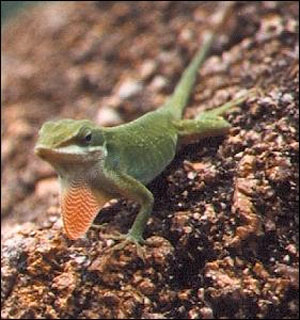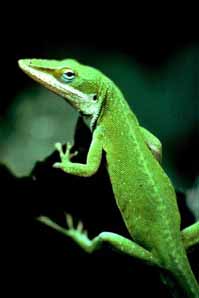Green anoles - Anolis carolinesis
Green anoles come from the southeastern United States, Cuba, Jamaica, and other Caribbean islands. Other anole species such as the Cuban anole, Jamaican Giant Anole are found in the same areas, except are not naturally found in the wild in the United States. They make great pets, but are somewhat delicate, and require more space and care than one would think. Most anoles available are wild-caught, and most are older juveniles or adults - this means they may carry internal parasites. It is a good idea to have a veterinarian do a fecal check after you have them home. You should also quarantine them before adding them to an existing group of anoles.
 Average Size - Typical size of an anole is 7-8" Average Size - Typical size of an anole is 7-8"
Life Span - They may live up to 5 to 7 years if healthy.
Diet - Anoles are mainly insectivorous. Crickets, waxworms and mealworms are available at most pet stores and can also be raised. They may occasionally take small amounts of fruit puree, offered in a tiny cup attached to one of their branches.
Feeding - In general, provide 2-3 bugs per day for each anole, unless you see that they are not eating them. If they eat them, and appear to want more, add one more at a time until you find how many they will take each day. DO NOT leave crickets or other bugs in your cage with your anoles. Babies will be about 1.5" long and will require pinhead crickets or fruit flies until they are about 3 inches long.
Housing - One male can easily be kept alone in a 10 or a 15 gallon terrarium. Groups of 3-4, however require much more space – do not house males together - step up to a 29 or 30 gal tank or larger.
Substrate - Use pelleted or mulch-type; however you can also use paper or cage carpet, or an edible substrate.
Habitat - Enclosures should be well planted with tall stiff leafed plants such as Snake plant, Orchids, bromeliads, and other tropical plants. Both vertical and semi-horizontal bamboo stalks should be provided for climbing and basking. The semi-horizontal bamboo pieces should be placed near fluorescent and incandescent lights for basking. Cork bark makes an excellent wall covering and also provides attachment points for air plants. It is also important to provide plenty of hiding places for anoles which will help to reduce stress.
Humidity should be relatively high, and can be achieved by spraying your cage several times a day with fresh water. A shallow pan of water may be placed in your cage, though anoles will not drink from it. Too much humidity can cause fungal diseases. Anoles regularly shed their skin; ensure humidity of habitat is appropriate to allow proper shedding.
 Temperature Daytime temps should range between 85-90 degrees F, with a basking spot of 95-100 degrees. Nighttime temps of 65-75 are fine. Use an incandescent light, ceramic heater or an under tank heat pad. Do not use hot rocks as they have a tendency to overheat and burn your pet Temperature Daytime temps should range between 85-90 degrees F, with a basking spot of 95-100 degrees. Nighttime temps of 65-75 are fine. Use an incandescent light, ceramic heater or an under tank heat pad. Do not use hot rocks as they have a tendency to overheat and burn your pet
Lighting These lizards are diurnal, daytime animals, so real unfiltered sunlight or UV/B is a must about 10 - 12 hours per day. If you can provide real sunlight – great – but make sure there is alot of shade available so your pets do not get overheated. You can buy an UVB-producing light bulb that will replace the need for sunlight. You should also provide a basking light
Water Spraying several times a day and providing a drip or spray system will provide the water your pets will need. They will drink from drips on the tank and water drops on plant leaves etc.
Normal Behavior and Interaction Anoles do well kept in small groups consisting of one male and 2-3 females. These little lizards are somewhat territorial, Two males cannot live together they are very territorial, one will become dominant and will stress out the other male to the point of poor health – get the picture. Newly acquired anoles will often bite, and may also drop their tails when frightened. Staying brown all the time is a sign of stress. Anoles have specially designed structures on their toes, so that they can climb walls or glass.
Recommended Supplies:
·
- Habitat with secure lid
- Thermometer
- Misting bottle
- Humidity gauge
- Book about anoles
- Light timer
|
- Plants and climbing branches
- Hide box or driftwood
- Water dish
- Misting system
- Undertank heat source
- Incandescent light
| Habitat Maintenance Change water daily. Thoroughly clean the tank at least once week: set anole aside in a secure habitat; scrub the tank and furnishings with a 3% bleach solution; rinse thoroughly with water, removing all smell of bleach; dry the tank and furnishings; and add clean substrate
Grooming and Hygiene Always wash your hands before and after touching your gecko or habitat contents to help prevent Salmonella and other infectious diseases
Signs of a Healthy Pet:
- Clear eyes
- Clear nose and mouth
- Body is rounded and full
|
- Active and alert
- Eats regularly
- Healthy skin
| Common Health Issues and Red Flags:
- Thin or shallow appearance
- Vomiting
- Discharge in nose or mouth
- Lethargy
- Abnormal feces or urine
|
- Decreased appetite
- Bumps, sores, or abrasions on skin
- Labored breathing
- Paralysis of limbs or tail
| If you notice any of these signs, please contact your exotic animal veterinarian.
As with all pets in this category, it is important that you find a veterinarian that practices in EXOTICS – this is critical. The typical small animal practitioner may not have sufficient knowledge in this area. Even this guide is general in nature and should not be used to diagnose your pet.
|


 Average Size - Typical size of an anole is 7-8"
Average Size - Typical size of an anole is 7-8"
 Temperature Daytime temps should range between 85-90 degrees F, with a basking spot of 95-100 degrees. Nighttime temps of 65-75 are fine. Use an i
Temperature Daytime temps should range between 85-90 degrees F, with a basking spot of 95-100 degrees. Nighttime temps of 65-75 are fine. Use an i